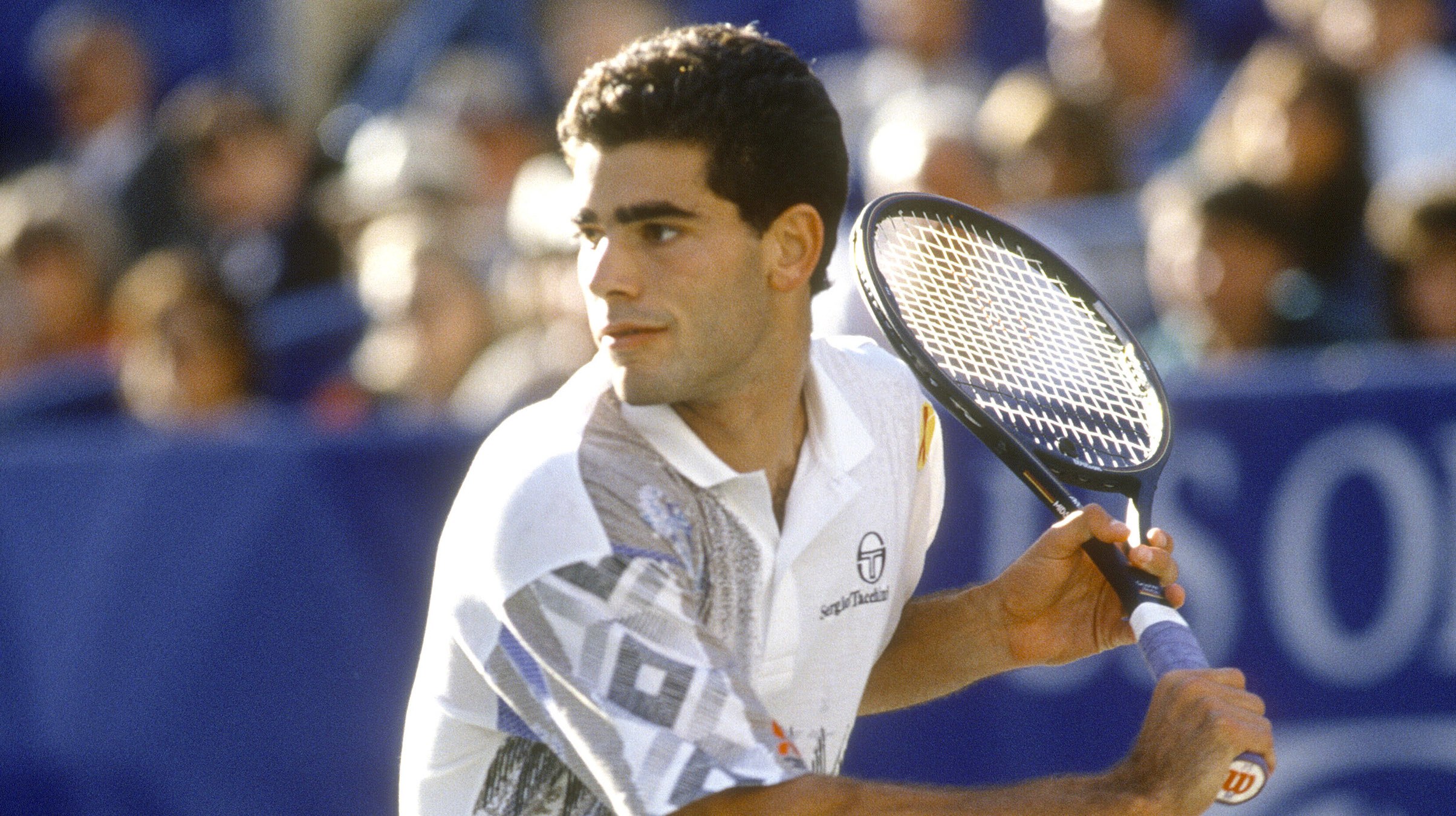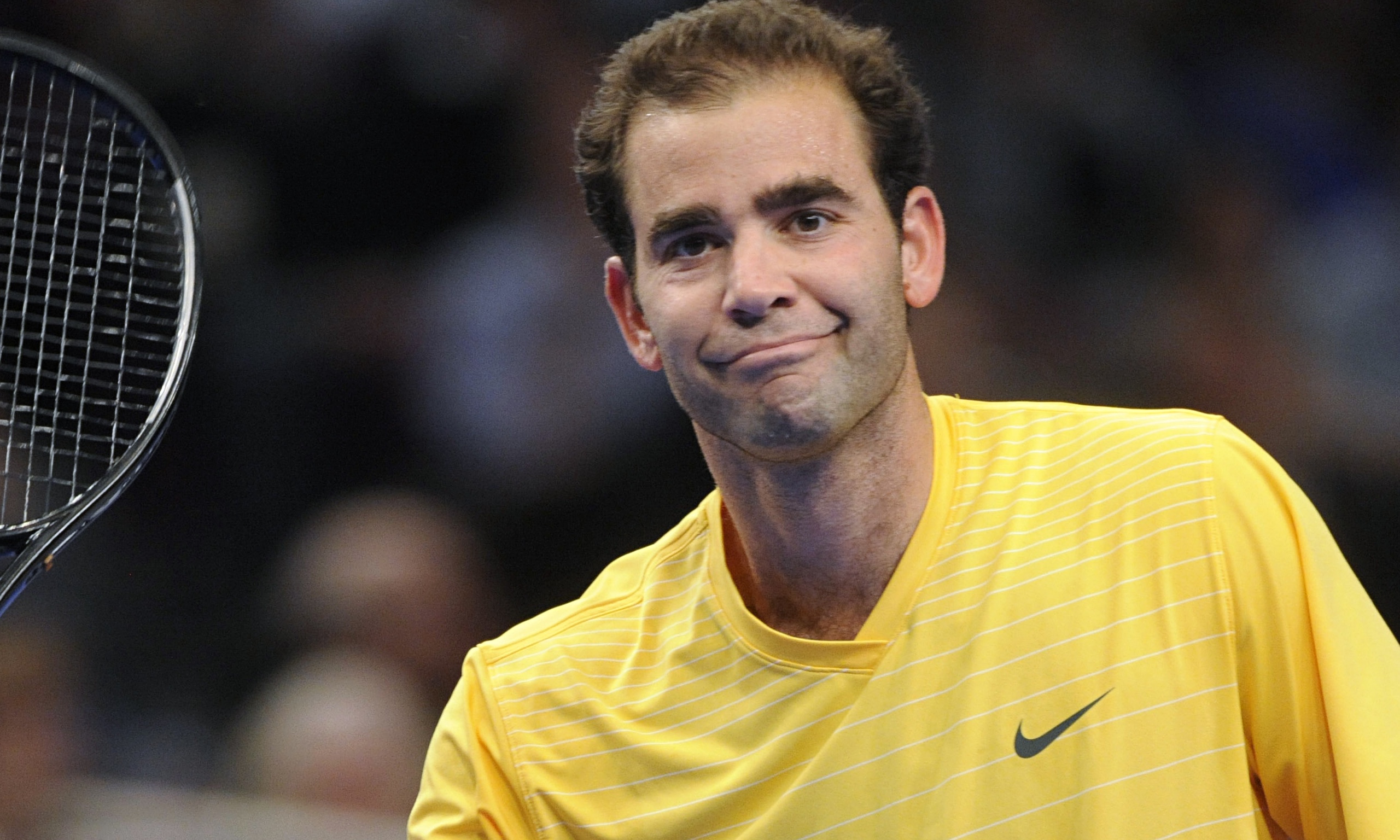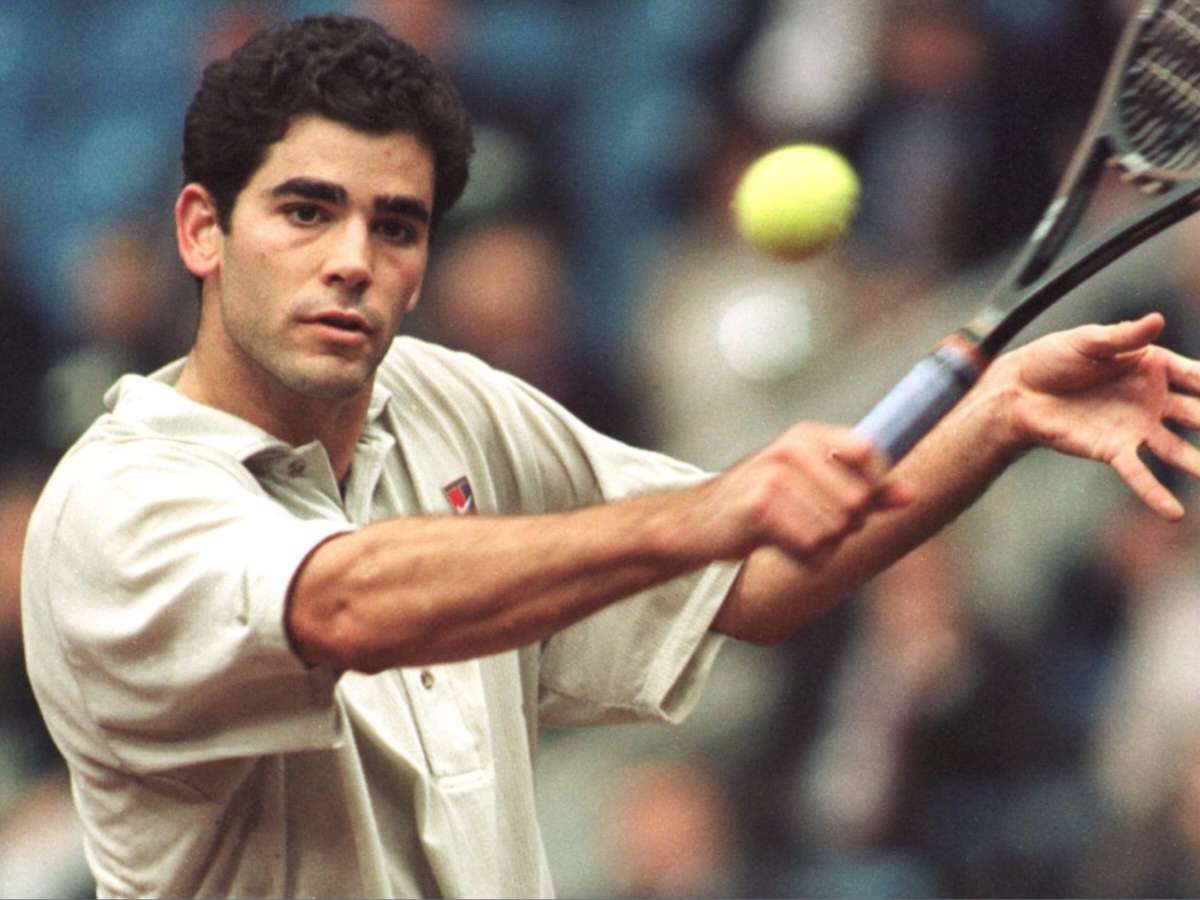Unleashing The Power: The Legacy Of Pete Sampras -Tennis Icon-
In the annals of tennis history, does any name resonate quite like that of Pete Sampras? His impact isn't just about trophies; it's about a transformation of the game itself, a shift in how tennis was played and perceived. To truly understand the sport, one must first dissect the elements that defined "Pistol Pete" a moniker earned for his lightning-fast serve and his ascension to becoming an undisputed icon.
Pete Sampras, a maestro of the court characterized by his awe-inspiring serve and relentlessly aggressive baseline presence, etched his name into the sport's history with unparalleled skill and a commitment that bordered on obsession. His journey culminated in a career adorned with multiple Grand Slam titles and a prolonged reign atop the world rankings, a testament to his dominance. He wasn't just a player; he was a force of nature.
The 1990s belonged to Sampras, a period where his influence on men's tennis was nothing short of seismic. He championed an aggressive style, raising the bar for aspiring players, showing that relentless attack and unwavering determination were key ingredients for victory. His influence permeates modern tennis, with technique and strategy still bearing his imprint. His game, a symphony of precise shot selection and relentless court coverage, altered the very DNA of the sport.
- Zefoy Is This Website Builder Right For You 2024 Review
- Who Was Melanie Jolys First Husband Facts Amp Details
| Category | Details |
|---|---|
| Full Name | Peter "Pete" Sampras |
| Dates of Birth/Death | August 12, 1971 |
| Country of Origin | United States |
| Major Achievements | 14 Grand Slam singles titles; numerous other notable victories; top ranking in the world |
| Notable Career Highlights | Record-breaking success; sustained high-level performance; impressive winning streaks |
For reference please visit atptour.com for more information.
This is an examination into the career of Pete Sampras, scrutinizing his evolution from a promising junior to a globally recognized champion and the enduring impact he has had on tennis.
Pete Sampras's era was defined by an unwavering pursuit of perfection on the court. An understanding of his core skills reveals how he attained his position as a dominant figure.
- Anna Ralphs The Comedic Genius Amp Her Inspiring Journey
- Unveiling Mikayla Demaiter Relationships From Past To Present
- Dominant Serve
- Aggressive Baseline
- Powerful Groundstrokes
- Strategic Court Coverage
- Exceptional Return of Serve
- Mentality for Victory
- Grand Slam Titles
- Sustained Success
The cornerstone of Samprass arsenal was his indomitable serve, which acted as both a weapon and a psychological deterrent. His aggressive baseline game, marked by surgical precision and thunderous groundstrokes, established him as an imposing figure from the first ball. He was a master tactician; his strategic court coverage, combined with a deft return of serve, often defused his adversaries' most potent strategies. But beyond raw talent and tactical brilliance, Sampras possessed an unyielding mental fortitude a hunger for victory that manifested in his staggering collection of Grand Slam titles. This prolonged reign at the top underscores a singular truth: achieving consistent excellence in tennis demands an uncompromising blend of technical skill and relentless will.
The dominance that defined Pete Sampras can be traced, in no small part, to his near-mythical serve. Its impact extended far beyond simple statistics, serving as a weapon of control, a tool for dictating tempo, and an avenue for relentless attack. The sheer force and pinpoint accuracy consistently pinned opponents on the defensive, gifting Sampras the upper hand in point construction. It was an advantage that, more often than not, he converted into match wins.
The ripple effect of such a serve on a player's overall trajectory is undeniable. Sampras harnessed it to relentlessly control baseline rallies, turning defense into instant offense. Complemented by his uncanny court awareness and punishing groundstrokes, it completed a comprehensive and terrifying package. The ability to seize early control stifled an opponent's offensive aspirations, forcing errors and seeding opportunities for Sampras to further impose his will. This translated into a championship pedigree, culminating in a record that few could match. The reliability and effectiveness of his serve became inextricably linked to his success, shaping the very nature of each point.
Thus, Pete Samprass serve was more than a mere technical skill; it was the keystone of his strategic approach. Its reverberations touched every point, every match, every milestone in his storied career. To grasp the nuances of elite tennis and how specific skills contribute to an overarching strategy, it's essential to dissect the correlation between a dominant serve and the overall success of players like Sampras.
The signature element of Pete Sampras' game, setting him apart and solidifying his place in tennis lore, was his aggressive baseline play. It wasn't just about overpowering the opponent; it was a carefully orchestrated dance of strategic positioning, acute anticipation, and the unleashing of explosive shots from the baseline. In stark contrast to the more passive styles prevalent at the time, Sampras relentlessly seized the initiative, forcing errors, dominating rallies, and exerting an almost suffocating level of control over each match, culminating in a remarkable win rate from baseline exchanges.
The success of this calculated aggression manifested itself vividly throughout Sampras's decorated career. Fueled by a devastating serve, he effortlessly transitioned to an unrelenting baseline assault, a strategy few opponents could effectively counter. He masterfully exploited weaknesses, dictating the pace and direction of matches, examples of which include relentlessly winning rallies from the baseline and making returns a treacherous affair for anyone daring to step onto the opposite side of the net. This constant pressure disrupted his opponents' rhythm, becoming a crucial instrument in securing countless victories.
Budding tennis hopefuls would be wise to study Sampras's aggressive baseline strategy. It serves as a vital lesson in taking the reins of rallies, dominating from the baseline, and pushing opponents to their breaking point. It transcends mere defensive play, instead championing the power of sustained offense and proactive court presence. Recognizing the significance of this approach allows players to develop a more dynamic and potent strategy, abandoning a reactive mindset for one defined by aggressive initiative. The legacy of Sampras stands as a testament to the transformative potential of a focused and flawlessly executed aggressive baseline strategy.
Pete Sampras possessed more than just a potent serve; his groundstrokes formed an equally vital facet of his comprehensive game. These were not simply displays of brute force; they were sophisticated tools, deployed with strategic intent and remarkable precision. His groundstrokes created an almost impenetrable barrier at the baseline.
- Impact on Point Control
Samprass powerful groundstrokes enabled him to command rallies from the baseline. His consistent ability to deliver the ball with both power and accuracy forced opponents into defensive postures, hampering their offensive potential. This dominion dramatically impacted the rhythm and flow of matches, making the threat of his powerful, precisely placed shots ever-present.
- Variety in Stroke Production
Although his serve often initiated the offensive, Sampras's groundstrokes were far from mere afterthoughts. He showcased a repertoire of strokes, unleashing forehands and backhands with both force and spin. This versatility enabled him to adapt to different opponents' tactics and court positions, consistently placing the ball in areas that made returns difficult, controlling trajectory with specialized spins. His ability to mix power and spin added another layer of complexity, making him an exceptionally difficult opponent to predict.
- Adaptability and Court Coverage
The strength of Samprass groundstrokes wasn't confined to a single approach. His exceptional court coverage, paired with the strength of his groundstrokes, made him incredibly versatile. He could generate powerful shots from both sides of the court, employing varying degrees of spin, enabling him to maneuver effectively and strategically, creating extreme challenges for his opponents' return game.
- Strategic Impact
The power and precision inherent in Samprass groundstrokes were strategically integral to his overall game plan. He consistently applied pressure, limiting his opponents opportunities to regain control of points. By blending power with calculated placement, he maximized his scoring potential from the baseline.
In summation, Pete Sampras's powerful groundstrokes were pivotal to his game. He consistently adapted his strategic placement and court coverage. A central aspect of his success was integrating various offensive abilities and commanding point development. It is of the essence to consider that success in tennis is affected by strategy.
Pete Sampras's triumph was largely rooted in his strategic mastery of the court. More than simple athleticism, his capacity to effectively position himself, foresee his opponents' actions, and capitalize on fleeting opportunities was paramount to his achievements. This skill was beyond footwork; Sampras recognized the connections between shot selection, court position, and the rhythm of each encounter.
- Anticipating Opponent Movements
Sampras was skilled at predicting opponents' shot selections based on past actions. His ability to anticipate opponents allowed him to ready himself strategically to intercept shots, counter effectively, and create chances for offensive maneuvers. It was vital to reduce the strength of opponent's shots and maintain his power.
- Positioning for Offensive Opportunities
His placement was not about defense; he used the skill to ensure offensive opportunities. By strategically placing himself, Sampras could adapt. He could expertly react to opponent shots and quickly begin rallies. This tactical movement allowed him to control the point.
- Exploiting Opponent Weaknesses
Sampras identified opponent weaknesses to get ahead. By identifying shortcomings, he could counter shots and place himself to counter vulnerabilities. This was beneficial in seizing command of points instead of passively waiting for opponent shots.
- Controlling Pace and Rhythm
The rhythm of the point was manageable because of Sampras's abilities. His ability to adapt on the court gave him dominance. Opponents felt pressured, resulting in diminished control of plays. The strategy was not about reacting. The set of calculated movements was designed to ensure dominance.
In conclusion, the strategy Sampras had for covering the court was not limited to movement. He adapted to situations to ensure offensive plays and rhythm control. This method allowed Sampras to have a consistent grasp of points. Control of placement proved to be a factor in his success.
A vital aspect of Pete Samprass game was his ability to return a serve. It was more than just a reaction; he could aggressively transition to offense. He could diminish his opponent, which showed his strategic brilliance.
- Neutralizing the Opponent's Serve as a Weapon
Sampras diminished any advantage an opponent might receive from a serve. He stopped them from dominating the rate of play or scoring opportunities. His forceful returns ensured he would quickly attain offensive plays.
- Controlling Point Development from Return
Sampras's strong returns enabled him to maintain domination of the point. His aggressive tactics limited an opponent's opportunity to progress. Dominance came from Sampras because he could diminish the effects of serves.
- Impact on Opponent's Strategy and Tactical Decisions
The returns Sampras made affected the choices of opponents. Knowing his abilities, opposing players adjusted their service plans. It altered serve strategies and affected potential for opponents, and match results.
- Creating Opportunities for Aggressive Play
By returning successfully, Sampras advanced his offensive plays. Powerful, precise returns could alter the point. By the end, Sampras was able to receive command of points and win matches.
Pete Samprass ability to return serves strategically played a pivotal role in his success. With this skill, he controlled point developments to seize strategic play in tennis. His returns were a huge part of his game.
Pete Sampras was a master of professional tennis. The mentality he had for victory was a critical part of his strategy. He was always focused, prepared, and calm. His passion meant that his technical skills always led to victory.
His mental stability was always visible. He always focused and maintained training regimens. He often thought of past victories to ensure his success. Sampras overcame problems and unexpected challenges to maintain consistency. His resilience meant he was always at his best. He was always focused, calm, and controlled to always persevere. Whether overcoming problems or managing tense match points, he maintained consistency.
The link between the victory mentality Sampras had to his success can be useful for all athletes. It shows the value of mental preparation and resilience. Development is not motivation, but meticulous planning and focus. Every player can use Sampras as an example to enhance performance and consistency.
Grand Slam titles and the career of Pete Sampras are closely connected. His victories reflected a grasp of his sport and dominance. To see the connections means his accomplishments are better understood.
- Sustained Excellence and Mastery
With several Grand Slam titles to his name, Sampras always performed well. It represented skill, strategy, and strength. He made an all-inclusive plan so that he could consistently adapt to opponents and be an excellent player.
- Mastering Diverse Opponents
Sampras had to beat several skilled players for his wins. His success reflected his mental stability, adaptability, and strategy. His performance meant he could adapt to several circumstances and playing styles.
- Performance Under Pressure
Grand Slam titles are challenging. Sampras was always prepared to perform during these moments. It reflects strategy, mental fortitude, and the passion to win. This emphasized the value of strategic planning for every element needed to win.
- Strategic and Technical Mastery
Grand Slam titles show mastery. Sampras's serves, court coverage, and aggressive tactics demonstrated technical skill. He used this to dominate matches and points.
Pete Sampras was successful for several reasons. His Grand Slam titles mean he had brilliance, dominance, and strength. They show how he could manage pressure and adapt. His victories emphasize what it takes to succeed in a sport.
The career of Pete Sampras shows sustained success and greatness in tennis. To examine the elements that had an effect on his accomplishments means that all fields will know how to have success.
- Consistent Skill Development
Sampras focused on developing his skills, he practiced a lot and adjusted to the plans and tactics of opponents. His commitment meant he practiced regularly, which is the reason he was able to maintain such a high-level performance.
- Strategic Adaptability
It was crucial that Sampras was able to adapt to new challenges. He could alter approaches and still maintain a high level of effectiveness. This meant he could counter new tactics and playing styles.
- Mental Fortitude and Resilience
Even during tense situations, Sampras managed pressure. He was able to overcome issues and stress. His resilience meant that he always had consistent success.
- Strategic and Tactical Awareness
His awareness helped him analyze patterns of opponents. This allowed him to control the rhythm of matches and exploit shortcomings.
In summary, Pete Sampras had long-lasting success. His commitment to skill growth, resilience, adaptability, and awareness were critical. By understanding these components, anyone can have sustained success.
This section covers questions about Pete Sampras. The goals of these answers are to give clarity and valuable facts.
Question 1: What were the key attributes that defined Pete Sampras's playing style?
Answer 1: He was known for his court coverage, baseline play, and powerful serve. His dominance over points and precision was thanks to dominant returns of serve.
Question 2: How did Sampras's serve contribute to his success?
Answer 2: One of his key offensive skills was his serve. It would determine the rhythm of matches and set up chances to get aggressive. His strong first serve meant he always had an advantage.
Question 3: What was the significance of his aggressive baseline play?
Answer 3: It meant he could dominate, begin rallies, and anticipate opponent movements. His strategic play and ability to dominate from the baseline made him a fierce player.
Question 4: How did Sampras handle pressure in high-stakes matches?
Answer 4: His mental fortitude meant that he always had success. By keeping focus, he was able to be consistent. This helped him win Grand Slam titles.
Question 5: What was the impact of his sustained success on the game?
Answer 5: He impacted the sport and set a high goal for excellence. His dominance, particularly his serve and baseline play, helped strategize plans.
Pete Sampras was able to dominate by having technical excellence and mental fortitude. His success can be thanked to his ability to adapt to the highest level.
- Who Is Rita Faez The Project Manager Extraordinaire Bio
- What Is Selcuksport Your Goto Guide News Amp More

30 Years Ago Pete Sampras rises to No. 1 on the ATP rankings for the

Pete Sampras believes Roger Federer could play for another 'four years

Where is Tennis legend Pete Sampras now and What’s his Net Worth?